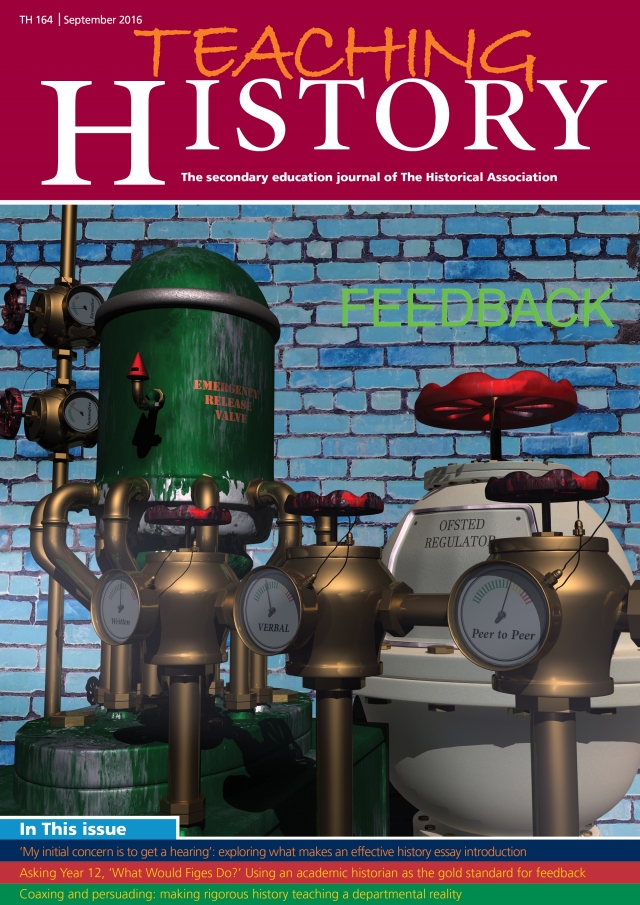Teaching History 164: Out now
Journal

If you have ever been lucky enough to teach in a classroom near the music department during a band rehearsal, you will know that feedback can be painful. The sensation of overwhelming noise drowns out all else, including rational thought.
The ‘noise’ around any discussion of assessment and feedback can have a similar effect: Accountability. Attainment. Criteria. Data. Flight Paths. Improvement. Interventions. Marking. Measurement. Monitoring. Objectives. Performance. Progress. Targets. Tracking. How is your blood pressure doing right now? Can you still think straight?
As accountability demands on schools have increased so has pressure on teachers to provide real-time evidence of pupil progress but also to establish and maintain a continual dialogue between teacher and student. Perhaps unsurprisingly, when confronted with the sheer volume of work demanded by this perpetual cycle of assessment and feedback, it is easy to get bogged down in the minutiae of the ‘how’ (should I use a green pen or red pen?) and lose sight of the more fundamental question of ‘what’.
Cutting through this cacophony of noise is not easy. Yet that is just what many history teachers have sought and seek to do, as the many articles published in this journal over the years can attest.1 Debates about what we can and should assess, how we assess it, and how we use our assessment to give feedback that will help students get better at history are long-standing and lively. Encouragingly, ongoing substantial curriculum change across all three key stages seems only to have given further impetus to these discussions. The vitality of this professional theorising is why we have chosen to devote a whole edition to exploring one particular element of assessment: feedback.
Feedback here is defined broadly, incorporating not just the teacher’s response to pupils’ work, but also the broader interactions between teachers and pupils in the classroom and discussions between professional colleagues both within school and across a wider subject community. Indeed many of the articles in this edition are a direct response to the recent work of other history teachers. Any discussion of feedback necessarily also concerns assessment. After all, feedback can only be effective if it is informed by a clear understanding of what it is we want pupils to get better at. In this sense thinking about feedback is simple. Strip away all the jargon and at its heart decision-making about feedback is first and foremost driven by one overriding question: what does it mean to get better at doing history? In practice of course deciding what to say and do to move pupils on is anything but simple. We are so used to constantly making judgements about the quality of pupils’ work and the products of that work, and using these judgements to inform our response, that we can easily forget just how complex making judgements and determining a response actually is.
Although the articles in this edition offer very different perspectives and approaches, they all wrestle with and embrace this complexity, while never losing sight of the question of what it means to get better at doing history.
Faced with planning a new A-level course from scratch while simultaneously having to implement a new whole-school assessment system, Carolyn Massey found herself returning to such enduring principles to guide her planning and assessment. Recognising the limitations of basing her feedback on examination mark-schemes she turned to historical scholarship in search of a different approach. By using the work of an historian as the basis for feedback she not only ensured that the feedback she gave was grounded in the discipline of history and therefore more useful to students, but helped students more effectively evaluate their own and one another’s writing.
Like Massey, Paula Worth also found herself turning to historical scholarship, this time in response to the question of what she could do to improve her pupils’ essay introductions. Having identified that her pupils’ introductions frequently lacked a clear purpose and were consequently dull, and responding to the concerns of pupils themselves, she used academic texts to identify a taxonomy of components of an introduction and designed a series of interventions to help students write more purposefully and with greater flair.
Both Rachel Arscott and Thomas Hinks, and Ian Luff address the challenges of developing rigorous and useful assessment systems in a post-levels world. They offer refreshingly honest accounts of the challenges history departments face in balancing whole-school demands against their judgement that for assessment and feedback in history to be meaningful it has to be subject- and task-specific. While they offer contrasting approaches, they share a determination that their approach to assessment and feedback should be firmly grounded in the subject discipline.
Nick Dennis adds to ongoing debates on the use of regular testing as a strategy for improving pupils’ knowledge retention and deployment by reporting on the results of his Masters research. He argues that the impact of such testing is not straightforward and in so doing offers us a valuable reminder of the danger of seeking silver bullets when it comes to assessment and feedback.

